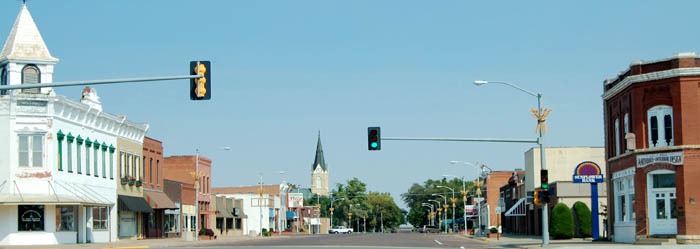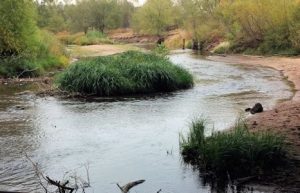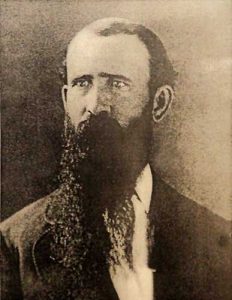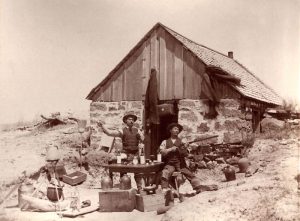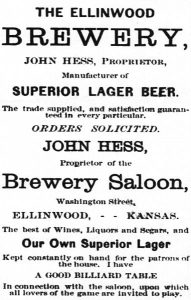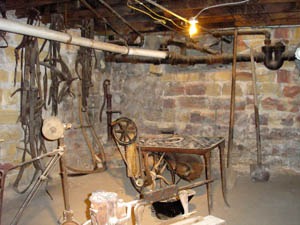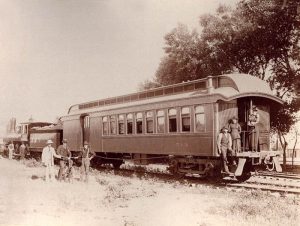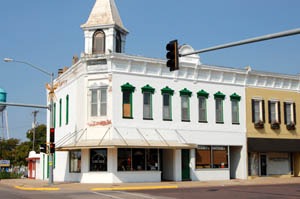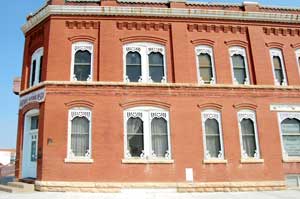Ellinwood, Kansas, located on the north bank of the Arkansas River in the southeast corner of Barton County, started when the Atchison, Topeka & Santa Fe Railroad planned to come through the area.
Long before a town was ever thought of, the Santa Fe Trail was established and its path met the north bank of the Arkansas River on the west edge of present-day Ellinwood. This point became a favorite camping place along the trail where wagon trains often stopped, and soldiers and traders rested. Near the trail stop was a burial ground where many pioneers were buried after crossing Cow Creek in eastern Rice County. Also, in the vicinity, a haying party was attacked and massacred by Indians in the late 1860s, so the region was well known before the Ellinwood was organized.
The first claim at Ellinwood was staked in August 1871 by Milton W. Halsey of Lyons, Kansas. Others who made some of the first claims in the fall of that year were Aaron Burlinson, William H. Grant, and William N. Halsey.
On November 9, 1871, Halsey, satisfied with the future route of the Santa Fe Railroad, returned and took possession of his claim. Aaron Burlison was the second permanent settler.
Halsey, who was a carpenter by trade, with Burlison’s help, built the first house in Ellinwood. It was made of boards and timber, measuring 12×24 feet. In November, Halsey moved his wife from Lyons. Mrs. Burlison also joined her husband, and both families lived in the single box house until 1872, when Halsey built a dugout for his family. Afterward, Burlison opened a store in the west half of his house. Others who had also staked claims also built shacks and dugouts.
When a post office opened on February 1, 1872, it was named for Colonel John R. Ellinwood, a civil engineer who worked for the Santa Fe Railroad. The first postmaster was Aaron Burlinson. The railroad was completed to the settlement in July, with the railroad pausing only long enough to erect a modest depot before pushing construction on toward the western border. That year, many of the settlers of the town of Zarah, which stood about halfway between Great Bend and Ellinwood, moved their buildings and business to Ellinwood. Rugar and Greever moved their building from Zarah to Ellinwood and converted it into a hotel that was utilized for that purpose for a few months before it was purchased and occupied by Landis & Williamson, who re-converted it into a store. J.L. Roberts moved his house and livery barn from Zarah, and George Towers also moved his house and blacksmith shop. R. A. Avery built the Avery House, which was the first regular hotel in town. Other early settlers were D.J. Whitten and G.W. Hollinger. That year, Ellinwood was included in the second school district organized in Barton County and was known as School District Number 2.
Shortly after the railroad’s arrival, the town grew large enough that the Arkansas Valley Town Company filed the township plat of Ellinwood. Although neither the founder nor the original settlers were German, many of the streets were given German names in order to appeal to German immigrant buyers. At that time, C.B. Schmidt, a German immigration agent of the Santa Fe Railroad Company, selected this locality as one of the points on the Santa Fe road where he would colonize German real estate buyers.
In 1873, several families arrived, including those of Isaac Bacon, Andrew Barngrover, and Wallace Bay. In addition, a great many young men came, who entered claims close to or adjoining the townsite, who boarded in town and added to the population. That year, a one-story brick schoolhouse was erected, which would later be enlarged with two good-sized additions. More homes were also built.
In 1874, Ellinwood continued to grow with many more dwellings erected. That year, F.A. Steckel put up a good frame building on Washington Street and opened a general merchandising store with a drug store included. Vancil S. Musil opened a much-needed lumber yard.
The grasshopper destruction of 1874 was a severe check to immigration, and the cattle trade was considered detrimental to their interests. To combat this, the farmers took drastic measures to stop the cattle drives from coming through, and in 1875 proclaimed that the drives would be disallowed on penalty of being prosecuted to the fullest extent of the law. However, by this time, the cattle trade was ready to move westward, so trouble was avoided.
As the German population grew, they brought with them the customs of the Fatherland. In 1875 a brewery was established — one of the first in western Kansas. The same year, an elegant and substantial iron bridge was built across the Arkansas River.
In 1876, Vancil S. Musil and F.A. Steckel built a flour mill. The first one to operate successfully in Barton County, the mill could grind about 100 bushels daily. The same year, Steckel and Musil opened a large farm implement business, and Mathias Rader put up a drug store. In 1876, the Catholics built a wood-frame church.
The immense amount of crops harvested in 1878 gave new life to immigration, and more people soon moved to the small town. Ellinwood became a city of the third class on April 22, 1878, and at an election on May 1, 1878, and F.A. Steckel was made the first mayor. That year, a solid two-story brick building was erected on Washington Street by Joseph Harnish. The first floor of the building housed a store and the upper story was occupied as a printing office by the Ellinwood Express and part by the city as a council chamber. A large grain elevator was also built by the Brinkman Brothers with a capacity of 12,000 bushels, two good frame store buildings were put up by Mathias Rader, and a number of dwelling houses were built.
That year, the Atchison, Topeka, & Santa Fe Railway and parties from Marion County and McPherson County chartered the Marion and McPherson Railway Company. In 1879, a branch line was built from Florence to McPherson, the next year, it was extended to Lyons, and in 1881 it was extended to Ellinwood. The line was then leased and operated by the Atchison, Topeka, & Santa Fe Railway.
In 1879, the German Lutherans built a church. By 1880, the town’s population had risen to 352, and the town was described as:
“Ellinwood is a live town … it is almost a German town exclusively, and everything is conducted according to German ideas. The businessmen, with scarcely an exception, are all German. They have their saloons, where they meet for conviviality, and their brewery where their beer is manufactured.”
By the late 1870s, the town boasted a Catholic and a Lutheran Church, as well as a Methodist Mission.
In 1881, the Deupree Brothers built a one-story brick building and opened a bank. Two more grain elevators were also erected — one by Vancil Musil and the other by Williamson & Ashton. That year marked the completion of the branch of the Santa Fe road from Florence to Ellinwood, where it connected with the mainline. The railroad then built a good stone roundhouse, with stalls for nine locomotives and blacksmith shops that were the means of causing a good many employees to locate in the town. The company also built a five-mile sidetrack and opened up an extensive material yard, or depot, where rails, ties, fence posts, and other materials were stored and from which other points along the line were supplied.
By 1888, Ellinwood had two schools, both of which were very busy.
The town’s rapid growth in the 1870s and 1880s had filled the business blocks of Ellinwood to capacity, so many new businesses began going underground. Before long, there were tunnels and passageways all along Washington Street to the side streets. This lower level developed over the years into various storefronts and shops, including sample rooms, bathhouses, gambling dens, saloons, meat storage, and even brothels. During the Prohibition years, these underground saloons provided great cover from inquiring eyes. Though the tunnels are not what they once were, they can still be toured today.
In 1892, the Catholics built the St. Peter and Paul Church, replacing the original wood frame church years earlier. The Gothic Revival-style church was built to replicate the churches the immigrants had known in Europe. It remained an active parish until 1986, and today the building is owned by the Sts. Peter & Paul Heritage Association a volunteer group determined to restore and maintain the church properly. Today, the church’s interior has retained all of its original ornate altars, statuary, and pews created by the German craftsmen. The church was added to the Kansas Register of Historic Places in 2007.
In 1894, John Wolf built the Italianate-style Wolf Hotel at a cost of about $10,000 as an addition to the Delmonico Hotel, which once stood just north of the Wolf Hotel. The addition included 15 rooms, a new lobby, underground stores, and the Bank of Ellinwood. Because he already owned several buildings on Main Street, his holdings were nicknamed “The Wolf Block.” The new combined lodging properties were then called the “The National Hotel.” The Ellinwood Advocate newspaper proclaimed the National Hotel was a “metropolitan hotel in every respect.”
Downstairs, which was part of the underground tunnel system that ran through Ellinwood, was the Drummer’s Room and Joe’s Snack Counter, which Joseph Meyer ran. The Drummers’ Room was provided as a place where salesmen could depart from the train to provide previews of their merchandise to potential customers. The town’s elite were invited first for selective buying and special garments. Afterward, businessmen would then get their chance to buy goods.
Over the years, the underground rooms often changed, housing a library, a gym, and an underground bar and cards room. The Wolf Hotel, now listed on the National Register of Historic Places, has been restored and still provides lodging, and a restaurant, also acts as an event venue and is a tour starting point for the underground tunnels. The Delmonico Hotel, which stood just north of the Wolf Hotel, is now a parking lot. The Wolf Hotel building is located at 104 East Santa Fe.
On January 20, 1908, the Bank of Ellinwood, which had occupied the west portion of the Wolf Hotel building, provided a big scare to the community. At that time, the deputy bank examiner for the State of Kansas completed his review of the bank’s statements and then proceeded to close the bank early in the day. The bank’s cashier, W. Leo Bockemohle, was arrested the very next day. Prior to that time, the Bockemohle family, who owned the bank, was a pioneer family of Ellinwood and was well respected in the town. Two days after the bank’s closing, a group of concerned citizens, including Mr. John Wolf and Mr. Fred Wolf, gathered together to pledge money for the start of a new bank owned by the businessmen and farmers of the area. Four days after the bank’s closing, W. Leo Bockemohle committed suicide, and his brother and bank president, Ed Bockemohle, was indicted and later convicted of falsifying bank statements. Two months later, in March of 1908, the Peoples State Bank opened its doors for business in the former Bank of Ellinwood offices, and the community began a fresh start with its new bank, owned by its investors.
The same year, the Wolf Milling Company was established and soon became one of the largest and best-equipped flour mills in the state. The mill, which had a capacity of 600 barrels per day, was operated by John Wolf and his son, Fred. Later additions were made in the next years, and the machinery consistently improved so that the mill buildings and surroundings covered about a square block of ground. The mill was progressive, successful, and a major employer for the town. The flour sold under the name of “Wolf’s Premium” was sold internationally.
In 1900, telephone lines were strung throughout the town, and phone numbers were issued. The train depot burned down in 1902 and was promptly rebuilt the same year; the concerns about fires in the town mounted, which resulted in two wells being dug in the town.
The 1900s was a decade of industrial growth for Ellinwood and a decade of modernization. Passenger and freight traffic on the railroad was still increasing, and in order to stimulate new milling operations to capitalize on the strong agricultural base of the community, a Commerce Club was begun to provide financial backing to anyone who wanted to establish a mill in the town. Within no time, a number of milling businesses sprung up, providing much-needed markets for grain farmers and prosperity to the new millers in town. New manufacturing businesses also began during this period, making sleds, farming equipment, and other products.
In 1909, after much anticipation, electricity was introduced to the Ellinwood. In 1910, Ellinwood was called home to 976 people and boasted two banks, two large flour mills, two creameries, a weekly newspaper called the Leader, three grain elevators, a telephone exchange, hotels, churches and was annually shipping large quantities of grain, flour, and livestock.

Atchison, Topeka, & Santa Fe Railroad depot in Ellinwood, Kansas.
World War I deeply affected Ellinwood as many had strong ties to Germany, and many residents with strong anti-German sentiments forced some of Ellinwood’s strongest German supporters to seek refuge in the underground tunnels, especially under the Wolf Hotel building because it was accessible to food and other services. After the war, many civic improvements were made, including installing sanitary sewer lines, a new school was built, and the streets were paved with brick.
In 1924, Fred Wolf, John Wolf’s son, added the Sunflower dining room to the Wolf Hotel. No expense was spared as it was artistically designed with sunflowers, wheat, terrazzo floors, and unique chandeliers that used only amber-colored bulbs. The tables were covered with crisp white linen tablecloths and linen napkins, with good silver flatware, and complemented with vases of fresh flowers. The outdoor patio area, the first of its kind in Ellinwood, was lined with a grape arbor. The prestigious restaurant soon drew people from far and wide and became the location of social events for the town. Beneath the restaurant, the Sunflower Sample Room provided a place to “sample” restricted “wet goods” during Prohibition.
Like other places across the country, the stock market crash in October 1929 brought much hardship to the town. However, through the 1930s, Ellinwood would fare better due to oil being discovered in the area. Soon, a pipeline was constructed to send oil to outside markets, and people began to move to Ellinwood to work in oil drilling. At one point, the local newspaper reported that there was no vacancy anywhere in the town.
By the end of the 1930s, industry was booming, and the Chamber of Commerce was formed to deal with the industrial boom. Oil remained the backbone of the economy during the 1940s, making many families incredibly wealthy. New houses were built, and schools were improved. However, with the outbreak of World War II, Ellinwood was once again faced with the troubles of being associated with Germany.
This time, Ellinwood received national press when newspaper columnist Walter Winchell called Ellinwood, Kansas, “a hotbed of German sympathizers.” Again, some Ellinwood residents were forced into the underground tunnels under the Wolf Hotel to wait out the anger associated with the war cause. When the war was over, the oil economy began to slow down, and young people began moving away.
The town’s population peaked in 1960 at 2,729. Ellinwood continued forward with its primary economy based on agriculture.
In 1972, the Hotel Wolf rented its last room, two years short of its 80th anniversary. In the following years, the building served a number of purposes.
In 1992, the railroad line from Marion to McPherson was sold to Central Kansas Railway, and the next year, after heavy flood damage, the line from Marion to McPherson was abandoned. The original branch line connected Florence, Marion, Canada, Hillsboro, Lehigh, Canton, Galva, McPherson, Conway, Windom, Little River, Mitchell, Lyons, Chase, and Ellinwood.
In 2013, the Wolf Hotel building sold after having operated as an antique store for several years. The new owner envisioned returning the old hotel to its former glory. Today, the historic hotel, as well as the Sunflower Dining Room, have been restored and are open to customers. The hotel also acts as an event venue and is a starting point for tours of the underground tunnels. It is located at 1 N. Main Street.
Ellinwood’s population today is 2011.
©Kathy Alexander/Legends of Kansas, updated August 2023.
Also See:
Santa Fe Trail – Highway to the Southwest
Sources:
Cutler, William G; History of Kansas; A. T. Andreas, Chicago, IL, 1883.
Blackmar, Frank W.; Kansas: A Cyclopedia of State History, Vol I; Standard Publishing Company, Chicago, IL 1912.
Biographical History of Barton County, Kansas, Great Bend Tribune, 1912
Barton County History Thesis
Ellinwood Chamber of Commerce
Ellinwood Historical Society
Historic Wolf Hotel
Wikipedia
Wolf Hotel National Register Nomination

